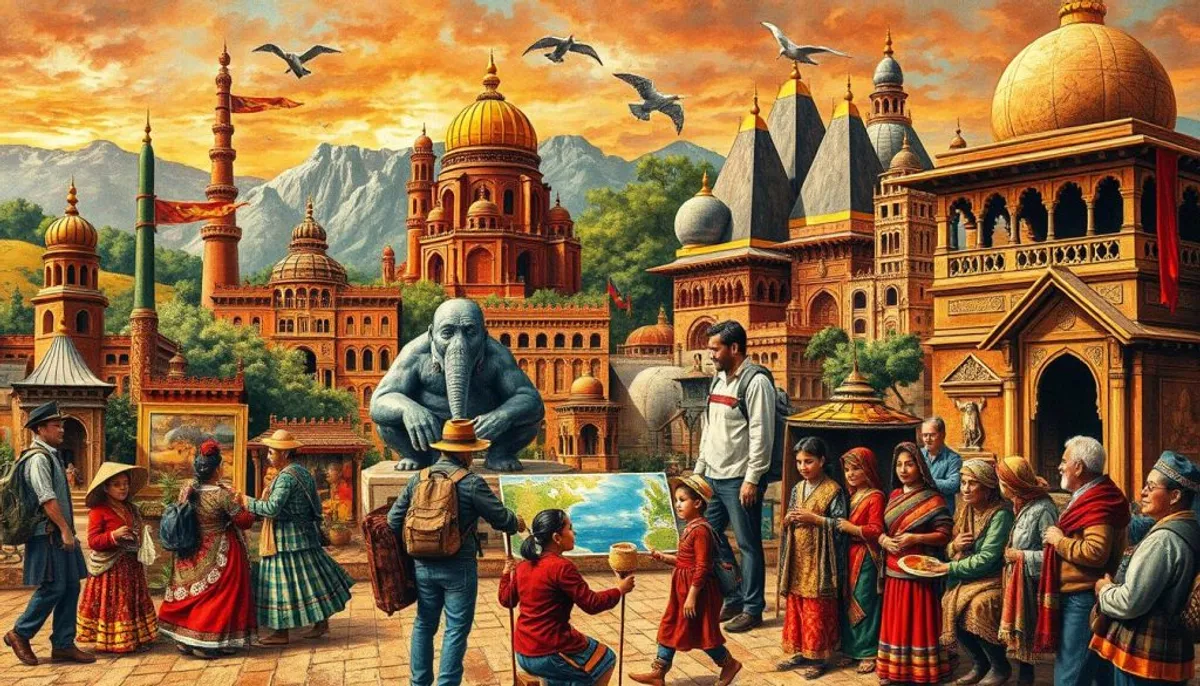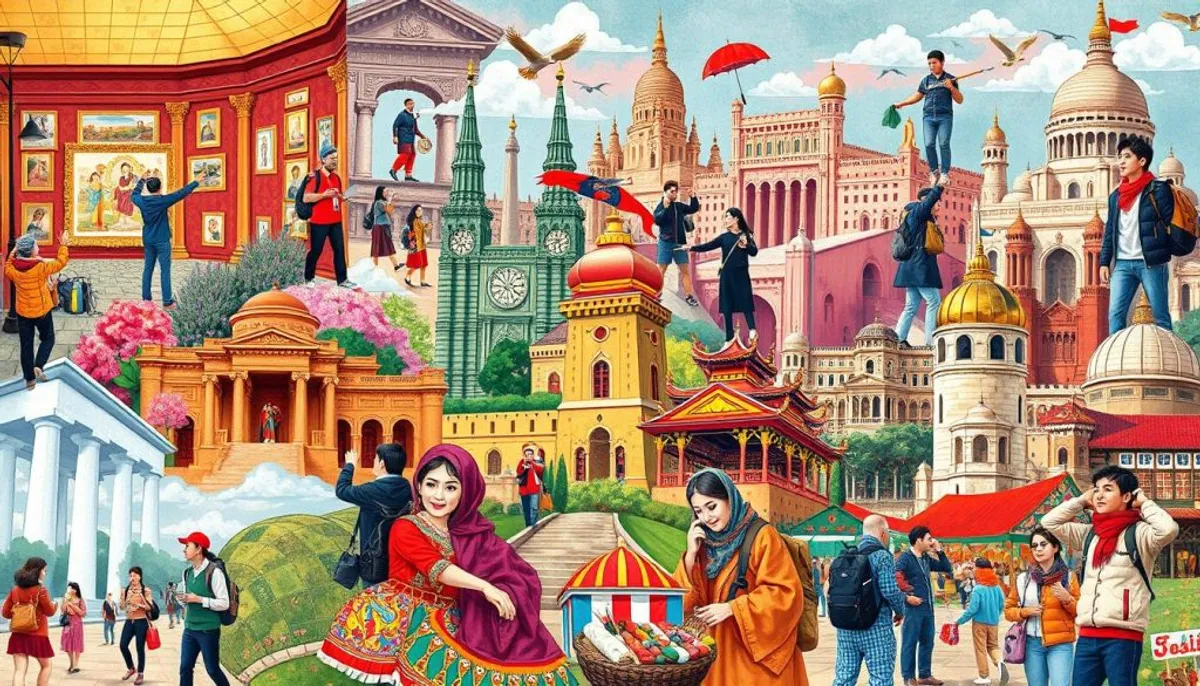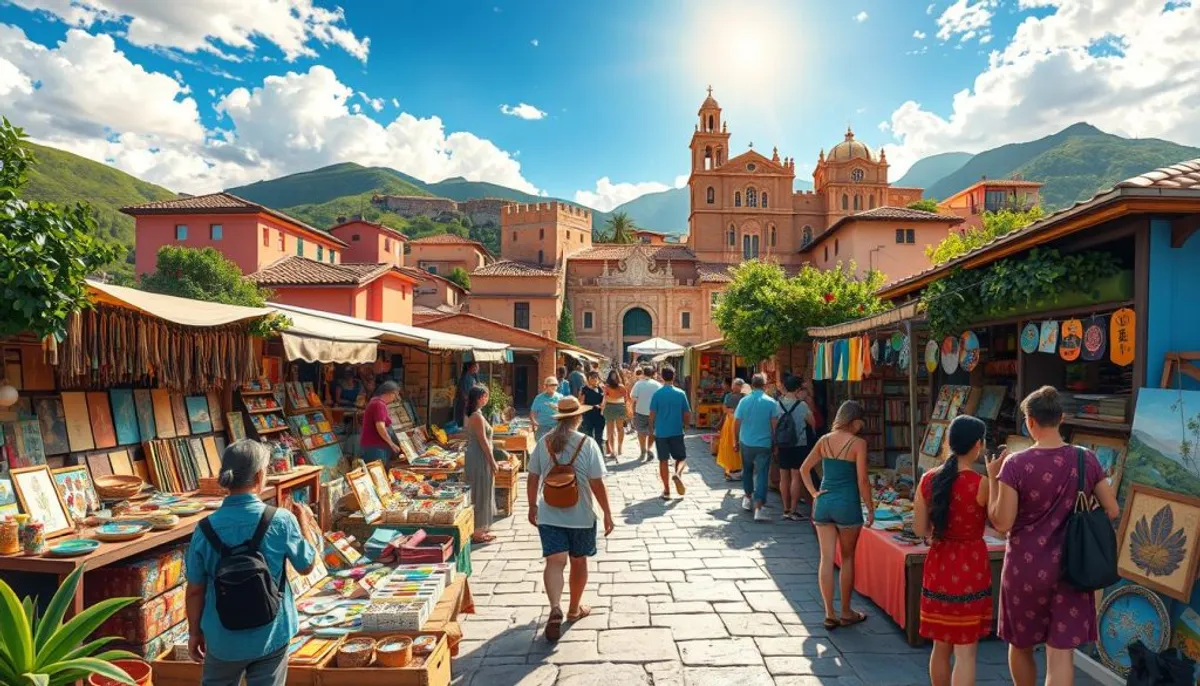The cultural tourism represents a unique adventure, allowing immersion in the heritage of a country. It offers travelers the opportunity to discover local traditions, explore historical sites, and experience authentic experiences. This form of travel is profoundly enriching, providing a unique perspective on the culture of a country.
Preferred destinations for these cultural trips are diverse. Cambodia, Peru, and Mexico stand out for their unique characteristics. In Europe, Greece, Turkey, and England are must-visit destinations. Asia, for its part, offers a rich array with India, Uzbekistan, Japan, Nepal, and Thailand.

Typical activities of a cultural trip include museum visits, guided architectural tours, and participation in local events. Gastronomy also plays an essential role. These trips are often organized in groups, following pre-established itineraries.
Compared to classic tours, cultural trips are slightly more expensive. However, they offer an in-depth and specialized view of the visited country. They attract those who share a common interest in culture and history, creating an enriching and friendly atmosphere.
What is a cultural trip: exploration and definition
A cultural trip represents a form of tourism that allows travelers to dive into the cultural heritage of a destination. It encompasses a range of immersive and revealing experiences. These experiences aim to enrich knowledge and appreciation of local cultures.
The definition according to the World Tourism Organization
The World Tourism Organization (WTO) defines cultural tourism as travel motivated by cultural reasons. This definition emphasizes the importance of discovery and learning about the cultural aspects of a destination. It highlights immersion in traditions and experiencing local cultural events.
The essential characteristics of cultural tourism
Cultural tourism is distinguished by immersion in local traditions and participation in cultural events. It aims to discover the heritage of a destination. Travelers aspire to live authentic experiences, thus allowing for a better understanding and appreciation of the visited culture.
The importance of tangible and intangible heritage
Cultural heritage is essential for attracting visitors. It includes tangible heritage, such as monuments and historical sites, as well as intangible heritage, such as traditions and know-how. European countries value their cultural identity to enrich their tourist offerings.
| Type of heritage | Examples | Impact on tourism |
|---|---|---|
| Tangible | Monuments, museums | Attracts art and history enthusiasts |
| Intangible | Festivals, gastronomy | Promotes cultural immersion |
The different types of cultural tourists
The typology of cultural tourists reveals varied motivations and behaviors. A study by the Economist Intelligence Unit identifies three main categories. These categories define the types of travelers attracted to culture.

The culture-motivated tourist
This traveler, representing 5 to 10% of cultural tourists, places cultural enrichment at the center of their experience. Their motivations are profound, seeking an intense cultural immersion. They view their trip as an opportunity for learning.
The culture-inspired tourist
This accounts for 15% of cultural tourists, attracted to prestigious cultural destinations. Their behavior is influenced by the fame of sites and attractions. They want to discover these places without engaging in an in-depth exploration.
The culture-interested tourist
This represents 5 to 10% of cultural tourists, taking advantage of a non-cultural stay to visit sites of interest. Culture is not their priority, but they appreciate the discovery opportunities that arise.
| Type of tourist | Proportion | Characteristics |
|---|---|---|
| Culturally motivated | 5-10% | Seeks an educational experience |
| Culturally inspired | 15% | Attracted to renowned sites |
| Culturally interested | 5-10% | Takes advantage of cultural opportunities |
This classification helps tourism professionals tailor their offerings. They can thus meet the expectations and specific behaviors of each type of cultural traveler by integrating features of cado culture bimpli.
The essential components of a cultural trip
A cultural trip is a rich and diverse adventure, allowing travelers to dive into the history and traditions of a place. These experiences represent 40% of global tourism, highlighting their growing importance.
The discovery of historical sites and monuments
Visiting historical sites is central to a cultural trip. In France, places like the Palace of Versailles or the Notre-Dame Cathedral attract millions. These sites offer a unique insight into French history and architecture.
Immersion in local traditions
Immersing oneself in local traditions is essential for understanding a culture. Participating in traditional festivals or learning artisanal trades allows travelers to experience an authentic and enriching experience.
The gastronomic and culinary experience
Gastronomy plays a central role in cultural travel. Discovering regional specialties and local culinary techniques offers a unique sensory dimension to the cultural experience.
Participation in festivals and cultural events
Cultural festivals are highlights of a trip. In France, events like the Avignon Festival or the Bayonne Festivals attract many visitors. They contribute to the local economy and offer total immersion in French culture.
| Component | Example | Impact on tourism |
|---|---|---|
| Historical sites | Palace of Versailles | Millions of visitors per year |
| Local traditions | Regional crafts | Preservation of heritage |
| Gastronomy | Regional cuisine | Discovery sensory |
| Cultural festivals | Avignon Festival | Local economic boost |
Creative tourism: a new cultural dimension
Creative tourism marks a significant evolution in the field of cultural travel. It offers unique experiences, allowing visitors to immerse themselves in local culture. This innovative approach transforms travel into a deep participatory experience.
Introduced in 2000, creative tourism encourages travelers to explore their creativity through authentic activities. Destinations offer craft workshops, local cooking classes, and traditional dance internships. These activities enhance local heritage in an interactive way, enriching the visitor experience.

UNESCO launched the Creative Cities Network in 2004, highlighting the importance of this form of tourism. This initiative aims to encourage collaboration between cities, placing creativity at the heart of their sustainable development.
Despite its potential, the integration of creative tourism into development strategies remains slow. Discussions about its benefits are promising, but its implementation requires time and effort.
| Aspect | Impact of creative tourism |
|---|---|
| Local economy | Stimulates creative industries |
| Cultural heritage | Enhances traditions |
| Traveler experience | Authentic and participatory immersion |
In France, cultural and tourist clusters are essential for the development of creative tourism. Digital media play a key role in disseminating information and creating innovative experiences. They offer new perspectives for the future of creative tourism.
The economic and social impact of cultural tourism in France
Cultural tourism is essential for the French economy. It stimulates local development and creates numerous jobs. The impact of cultural tourism is visible in the preservation of heritage and the generation of income for local communities.
Key figures in the sector
Statistics show the economic importance of cultural tourism. In France, this sector is a major component of GDP. It attracts millions of visitors each year. Here are some key data:
| Indicator | Value |
|---|---|
| Share of tourism in French GDP | 7% |
| Number of jobs generated by tourism | 2 million |
| International visitors to France | 90 million |
| Share of cultural tourism in global tourism revenues | 40% |
The economic benefits for territories
Cultural tourism has a positive impact on the national economy. Cultural sites, such as the Louvre and the Palace of Versailles, attract millions of visitors. This generates significant revenue for regions. Festivals, such as the one in Avignon, boost the local economy by attracting tourists and creating business opportunities.
Job creation and local development
Cultural tourism is a driver of local development. It creates numerous jobs, from guides to restaurateurs. This sector contributes to the preservation of heritage and the revitalization of rural areas. It strengthens local cultural identity. Investments in tourist infrastructure improve the quality of life for residents.
Conclusion
Cultural travel proves to be a fundamental pillar of global tourism. It accounts for 40% of global tourism revenues, influencing the future of the sector. France, as the top destination, welcomes 90 million visitors, capitalizing on this trend. Its 71,600 cultural sites, such as the Louvre and the Eiffel Tower, captivate millions every year.
Innovation is booming in this field. The Atelier des Lumières, for example, attracted 1.4 million visitors upon its opening. These immersive experiences meet the aspirations of contemporary travelers, seeking unique and enriching discoveries.
Sustainability is becoming a major issue. Cultural tourism professionals must find a balance between heritage preservation and economic development. This balanced strategy will ensure the sustainability of the sector, offering unforgettable experiences to visitors from around the world.
RelatedRelated articles


